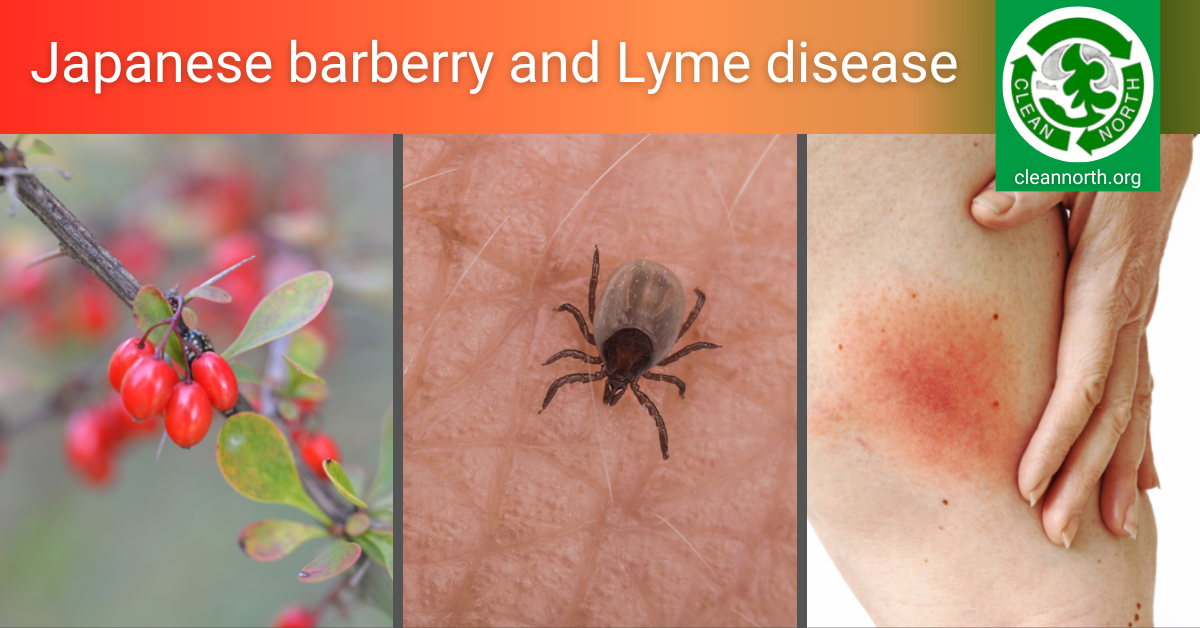
Japanese barberry is a popular low-maintenance shrub that comes with a steep hidden cost: It’s an invasive species that not only can disrupt ecosystems but also foster Lyme disease. If you have any barberry on your property, we encourage you to dig it up, dispose of it in the trash, and replace it with a native shrub.
Our thanks to Cathy Kavassalis of the Canadian Coalition for Invasive Plant Regulation for inspiring this post.
What is Japanese barberry?
This shrub is native to Japan and easy to identify by its small oval leaves, plentiful small thorns, bright red berries, and colourful leaves in fall. A resilient plant, it tolerates a wide range of growing conditions—even deep shade.
Japanese barberry is similar to common/European barberry, another invasive shrub. The European one arrived in North America first but turned out to be an alternate host for black stem rust, a serious disease of grains. So Japanese barberry was pushed as an alternative. However, it turned out to be invasive as well—and now we know it also gangs up with ticks to spread Lyme disease.
How does Japanese barberry foster Lyme disease?
According to research done in the United States, Japanese barberry plants create a lovely humid microclimate in which blacklegged ticks thrive. One study in Connecticut showed how barberry presence affected tick populations:
- Barberry not contained—120 infected ticks per acre
- Barberry contained—40 infected ticks per acre
- No barberry—10 infected ticks per acre
Deer are also part of the equation as they eat just about everything in the forest except barberry. Their turning up their noses at barberry gives it an advantage over native plants. Barberry also leafs out earlier than and drop its leaves later than many plants, giving it a photosynthetic (energy) advantage.
Mice are another Lyme disease ally: They like hiding out in barberry and are a common host for blacklegged ticks.
“But barberry is not invasive in my yard!”
Truly, we understand it’s difficult to hear that a plant you love may have a dark side. But we can’t just ignore the invasive garden plant problem. We must face up to it to prevent more enormous costs to ecosystems, the economy, and human health. Invasive species literally break ecosystems, are costing our country billions, and can even hurt us, for example, by helping Lyme disease spread.
And please know that humans are no match for invasive garden plants. They are clever and resourceful and will outfox us. How they can escape:
- Plants can unfurl roots into neighbouring properties.
- Birds and other wildlife can eat the seeds and poop them out in new locations including vulnerable natural areas.
- Seeds can hitch a ride on muddy boots or paws of pets/wildlife or via rain washing them away.
- People may thin invasives and then dump the debris in nearby natural areas, where they drop seed or form roots and take hold.
- People may share or sell one plant not realizing that it also contains roots or seeds from an invasive species.
And what happens to the invasive species in your yard when you move or pass away? The next person to live there may have no idea the yard has invasive species in it.
How to get rid of barberry
Note that we said “barberry” not “Japanese barberry.” The European barberry is also invasive and should also be eradicated.
The best way to get rid of barberry:
- Dig it out making sure you get as much of the roots as possible
- Rake up any foliage and berries
- Bag all and dispose of in the trash
- Watch for shoots in future years and remove as soon as you see them
What can you grow instead?
Planting another vigorous shrub in the place of barberry will help reduce its ability to come back. Consider these wonderful native alternatives:
- Buttonbush
- Chokeberry
- Nannyberry
- Native bush honeysuckle (not the invasive ones!)
- New Jersey tea
- Ninebark
- Red osier dogwood
- Sandcherry
- Snowberry
Google these species to see if they will grow well in your yard based on your soil and level of sunlight/shade.
FYI: Fall is a wonderful time to plant shrubs! Just make sure they are well watered going into winter.
And finally…
We will leave you with the reminder that reducing barberry also reduces blacklegged ticks and Lyme disease risk. Blacklegged tick populations are rising in our community, and so is the rate of Lyme disease. Let’s do everything we can to stem the Lyme disease tide.
Want to know more?
- Email us at info@cleannorth.org.
- Read a Clean North blog post on how climate change is spreading Lyme disease in Ontario
- Join the Master Gardeners of Ontario Facebook group (science based, lots of good info on invasive plants)
- Check out the Canadian Coalition for Invasive Plant Regulation and Ontario Invasive Plant Council websites





One Reply to “Hate ticks? Get rid of your Japanese barberry”
Comments are closed.